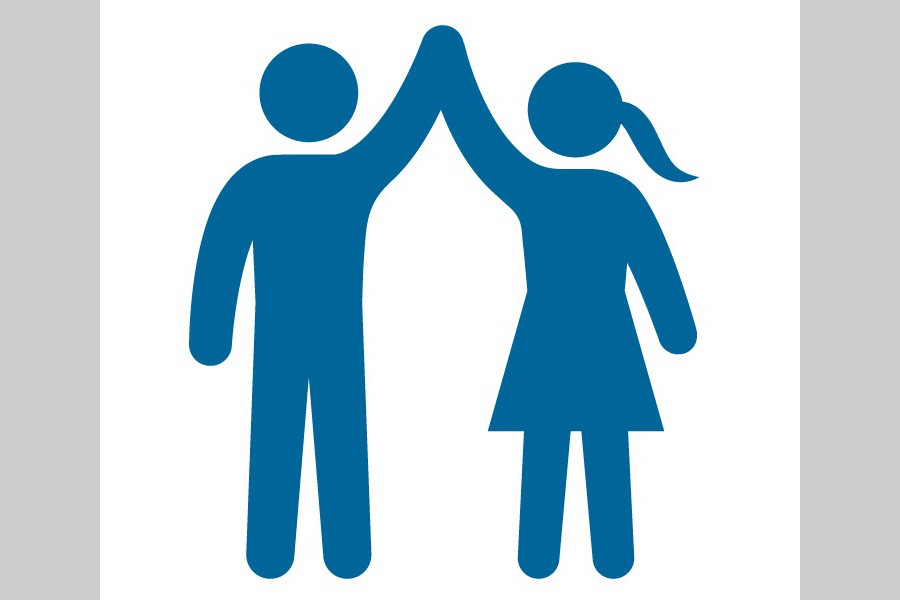Bangladesh's latest ranking in the Gender Equality Index prepared by the World Economic Forum (WEF) is a cause for celebration. First, its progress in bridging the gender gap has been appreciably fast and steady. How its journey on this daunting course has steadily improved can be realised from the fact that in 2006, the country was ranked 91st and last year 72nd and this time it is 47th -a great leap forward. Second, the country has been way ahead of its neighbours like India at 108th slot, Sri Lanka at 109th, Pakistan 143rd and Nepal 111th. Even China lags far behind at 100th position. This looks to be a phenomenal achievement for Bangladesh.
Now what are the criteria for measuring the progress in narrowing the gap between males and females in countries across the globe? The main areas of reckoning are: a) economic participation and opportunity; b) educational attainment; c) health and survival and d) political empowerment.
Laudatory though the 47th ranking for Bangladesh, it should not make its citizens complacent. Reading between the lines, one can discover gross discrimination in many of the key areas. In terms of economic participation and opportunities women are ranked 129th among the 144 countries surveyed. On labour participation the ranking is 124 and on wage equality for similar work the ranking is 104. Similarly the rankings are 108, 113 and 116 for income earned, in positions of legislators, senior officials and managers respectively and employment as professional and technical hands.
In this context the ratio between the male and female on all these heads can be illuminating. The ratio of male-female participation in labour is 83.3/45.1. In terms of annual income on purchasing power parity (PPP), the share for a woman is US$ 2,364 as against a man's US$ 4,776. Clearly, women are discriminated against in terms of income. But then their income is much higher than their counterparts in India and Pakistan with an income of US$2,184 and US$1,498 respectively.
It is on the education front that the gender parity has been achieved remarkably. On certain counts, females are ahead of males. So far as enrolment in primary and secondary education is concerned, girl/boy ratios are 95.1/86.1 and 61.1/53.6. In tertiary enrolment women are lagging behind but by not much with a ratio of 11.4/15.4 in between. In terms of literacy too the same applies with 69.9 for women to 75.6 for men. This might be for the late entry of women on the scene. They are narrowing the gap and soon the parity is likely to be achieved in education between sexes.
It is on health and life expectancy where the position of women in Bangladesh has exposed its weakness more than anywhere else. The rankings are a distant 125 and 132 respectively on these two vital counts. As a consolation, though, women fare better than men in healthy life expectancy.
Then comes the issue of political empowerment on which issue women's score is not outstanding despite the fact that the country's prime minister, opposition leader, speaker and the leader of the second largest political party are all women. In terms of women's representation in parliament and ministerial positions, the ratios between men and women are 20.3/79.7 and 6.3/93.8 respectively.
This is a broad view of the position of women in Bangladesh society. But what is likely to escape notice is that the average count does not reflect the true picture. For example when the country ranks 1 on account of sex ratio at birth, it is not an achievement like others. The only thing that goes to its credit is that people do not go for infanticide on embryonic sex detection.
The other reality that threatens most other achievements concerns violence against women. Although the incidence of acid throwing on women is low now, the curse has not totally disappeared. Burning or killing of women for dowry is very much there. Now the rapacious sexual violence has made girls' and women's lives horribly insecure. Rape and killing have been making screaming headlines day after day without any remedy. If this continues, women are unlikely to realise their potential.
Women are maltreated both in families and commercially. At a level, they are still considered men's property. They do not enjoy freedom of movement and choice. When sex crimes continue to maraud this land like pestilence, voice of opponents to women's freedom gains further ground for understandable reasons. Then lurid commercial use of women in various forms including on-screen abuse of female body only makes the matter worse. Women really cannot discover their own identity in a society full of inhibitions and distorted values.
The fact that girls are outpacing boys in enrolment at two key levels of academic education has to be exploited with an eye to the future. This is where the change maker will ultimately come from. Better education and employment will allow them to take their rightful position in society. Sexual aberrations can be overcome through education and cultural orientation. If sports and cultural activities can be introduced for children at a tender age, they will know how to respect each other. Families should inculcate in them respect for girls and women. Thus society will grow in mental maturity as well to fight against discriminations of all forms.


